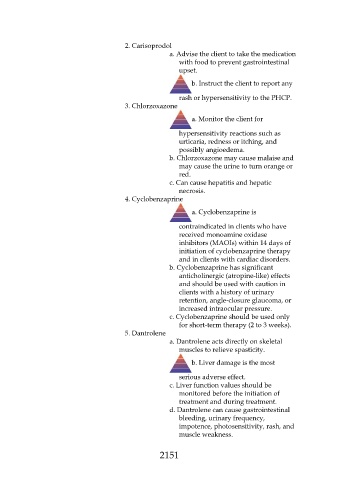Page 2151 - Saunders Comprehensive Review For NCLEX-RN
P. 2151
2. Carisoprodol
a. Advise the client to take the medication
with food to prevent gastrointestinal
upset.
b. Instruct the client to report any
rash or hypersensitivity to the PHCP.
3. Chlorzoxazone
a. Monitor the client for
hypersensitivity reactions such as
urticaria, redness or itching, and
possibly angioedema.
b. Chlorzoxazone may cause malaise and
may cause the urine to turn orange or
red.
c. Can cause hepatitis and hepatic
necrosis.
4. Cyclobenzaprine
a. Cyclobenzaprine is
contraindicated in clients who have
received monoamine oxidase
inhibitors (MAOIs) within 14 days of
initiation of cyclobenzaprine therapy
and in clients with cardiac disorders.
b. Cyclobenzaprine has significant
anticholinergic (atropine-like) effects
and should be used with caution in
clients with a history of urinary
retention, angle-closure glaucoma, or
increased intraocular pressure.
c. Cyclobenzaprine should be used only
for short-term therapy (2 to 3 weeks).
5. Dantrolene
a. Dantrolene acts directly on skeletal
muscles to relieve spasticity.
b. Liver damage is the most
serious adverse effect.
c. Liver function values should be
monitored before the initiation of
treatment and during treatment.
d. Dantrolene can cause gastrointestinal
bleeding, urinary frequency,
impotence, photosensitivity, rash, and
muscle weakness.
2151

